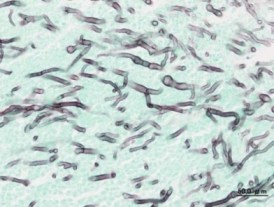Aspergillosis
Aspergillus flavus is the second leading cause of Aspergillosis. The first is its relative Aspergillus fumigatus. To learn more about Aspergillus fumigatus check out its webpage!
Aspergillosis is an infection by the fungus Aspergillus flavus. Aspergillosis can occur in multiple different organs in various animals, including humans. Most animals have efficient mechanisms for the prevention of infection by Aspergillosis. However, if those mechanisms are impaired, this gives Aspergillus the opportunity to infect an organism. Examples of such cases include individuals who have received cancer treatment, are recovering from surgery, have or had tuberculosis, chronic obstructive pulmonary disease, bronchiectasis or have HIV.
The most common form of aspergillosis is pulmonary aspergillosis. This is caused when Aspergillus infects the body and grows in lung cavities. Previous health issues causing scarring of the lung tissue, such as tuberculosis, are what typically create these lung cavities. Once the lungs are infected, Aspergillus begins to grow into a fungal ball called an aspergilloma or mycetoma. This is what makes the individual ill, because the fungus puts out allergens or toxins into the body.
Other forms of Invasive Aspergillosis
Although less common, Aspergillus can infect other tissues such as the central nervous system, sinuses, bone, heart, kidney, eye, blood and skin.
Diagnosis and Treatment
At first, Aspergillosis may not be noticeable to an individual who is infected, but in time symptoms begin to emerge such as: breathing problems, chronic cough, coughing up blood, weight loss, feeling tired and fatigue. Aspergillomas can be detected by x-rays, bronchoscopy, or blood tests. Patients may also be asked for a skin test to measure sensitivity to Aspergillus allergens. Treatment usually consists of taking drugs, such as voriconazole. However injections of anti-fungal drugs or even surgery may be necessary depending on the severity of the infection.
To learn more about organisms that cause diseases explore the following links: Plasmodium falciparum, Borrelia burgdorferi, Mycoplasma pneumonia, and Heliobacter pylori.
If you are curious about why I created this webpage go to my contact page!





